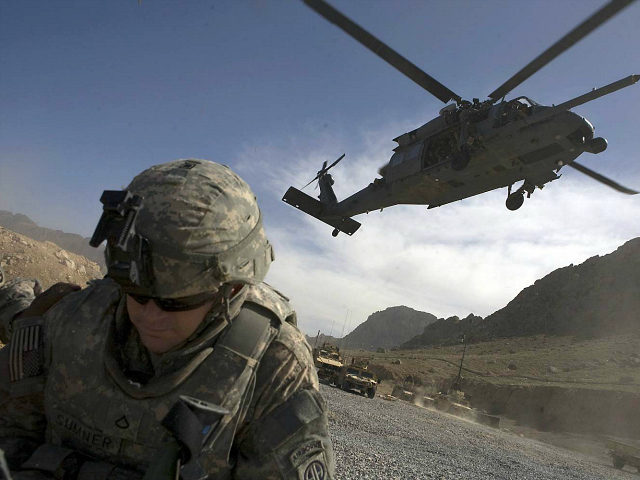American troops in Afghanistan are still fighting the Taliban under an authority granted by former U.S. President Barack Obama in June 2016 that allows American service members to aggressively target the jihadists, Breitbart News has learned.
Before the June 2016 change, Obama only allowed U.S. troops to respond to the Taliban in a defensive, reactive kind of manner, rather than offensively — ordering them to wait for a situation to develop rather than getting in front of it.
The former president took away the U.S. military’s authority to offensively attack the Afghan Taliban after he declared the U.S. combat mission in Afghanistan over at the end of 2014.
By the time Obama granted the American forces the June 2016 authority to go after the Taliban, the terrorist group had gained control of more territory than during any other since the United States removed it from power in 2001, fueling the deteriorating security conditions afflicting Afghanistan to this day.
Adam Stump, a Pentagon spokesman, declined to tell Breitbart News whether President Trump will make any changes to Obama’s June 2016 authority or whether the new administration has officially resumed U.S. combat operations in Afghanistan.
Known as “strategic effect,” Obama’s June 2016 authority allows American service members to strengthen Afghan offensives with American combat advisers, airstrikes, surveillance aircraft, and pilots to fly alongside the fledgling Afghan air force.
“In June 2016, the commander of U.S. Forces-Afghanistan was given the ‘strategic effect’ authority,” Stump told Breitbart News when asked if American troops are allowed to offensively target the Taliban under Trump. “‘Strategic effect’ refers to distinctive opportunities to support Afghan operations that will significantly further the overall security objectives for Afghanistan, which are to enable the Afghan National Defense and Security Forces [ANDSF] to achieve Campaign objectives and ensure the viability and stability of the Government of Afghanistan.”
“Our main objective is to prevent Afghanistan from being used as a safe haven for terrorists to attack the United States and our allies,” he continued. “The United States will support the Afghan government and security forces in their fight against Taliban, al-Qaeda, ISIS, and other insurgents and prevent re-establishment of international terrorist safe havens in the country. We will maintain pressure on the Taliban to join a peace process with the Afghan government to end the war in Afghanistan.”
According to a top U.S. general, additional U.S. troops are soon expected to join the estimated 8,300 who are already in Afghanistan as part of Trump’s new plan.
During a televised speech announcing his new strategy to end the Afghanistan war, President Donald Trump declared:
My administration will ensure that you, the brave defenders of the American people, will have the necessary tools and rules of engagement [ROEs] to make this strategy work, and work effectively and work quickly.
I have already lifted restrictions the previous administration placed on our warfighters that prevented the Secretary of Defense and our commanders in the field from fully and swiftly waging battle against the enemy. That’s why we will also expand authority for American armed forces to target the terrorist and criminal networks that sow violence and chaos throughout Afghanistan.
The Pentagon spokesman declined to provide examples of the restrictions the president has lifted and the potential changes to the ROE the commander-in-chief is planning while the U.S. troops continue to operate under Obama’s 2016 rules of engagement.
Nevertheless, some military officials have credited President Trump with giving the military far broader authority than his predecessor to target terrorists in Afghanistan.
Even after the U.S. military began to aggressively target the Taliban again in June of last year, the former administration continued to insist that Obama had not resumed the U.S. combat mission.
Before the June 2016 authority, U.S. troops only had the to right act in self-defense (in-extremis) when confronting the Taliban.
In other words, American troops had to wait for the Taliban to attack first before they could respond.
“Now, with the new authorities that we have now, as of June [2016], we’re able to then provide combat enablers to assist the Afghans who are now … taking the initiative against the enemy … so it’s more of an offensive nature to that operation that we’re assisting,” explained Gen. John Nicholson, the top commander of U.S. and NATO troops in Afghanistan, in July 2016.
“The in-extremis was the defensive part and the strategic effect was the offensive part,” he noted.
During his Afghan strategy speech Monday, President Trump promised victory to the American people, which he defined as “attacking our enemies, obliterating ISIS, crushing al Qaeda, preventing the Taliban from taking over Afghanistan, and stopping mass terror attacks against America before they emerge.”

COMMENTS
Please let us know if you're having issues with commenting.